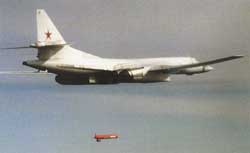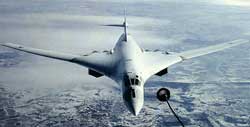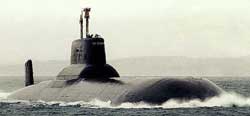 |
| Russian Tu-22
Bomber |
Russia will soon launch a mock nuclear attack against
the U.S. and Britain during military exercises over the
next week.
Moscow's Nezavisimaya Gazeta reports that Russia's
strategic bombers and nuclear submarines "will deliver
hypothetical nuclear strikes on the U.S. and Britain,
while locating and destroying aircraft-carrier groups of
the U.S. Navy."
 |
| TU-160 Blackjack
Strategic Nuclear Bomber launching a new cruise
missile. |
The massive air, sea and land maneuvers are being
conducted in the wake of America's stunning victory over
Iraq, a long time client state of Russia.
The paper said the exercises are taking place
because, "Russian military leaders have learned a lesson
from the Iraq war, and intend to show the U.S. and its
allies their determination to repel any potential threat
coming from the West."
If the mock strikes were real, they would kill 125
million Americans in the first three days of such an
attack, with tens of millions more casualties in the
weeks after.
The Russian military, in plans drawn up at the
request of President Vladmir Putin, argues that the only
way Russia can deal with an escalating regional conflict
with the U.S., would be to employ nuclear weapons.
Though Russia's military has been considerably
downsized since the end of the Cold War, and its
conventional forces hold little weight against a modern,
equipped army, Russia has continued to invest heavily in
strategic and tactical nuclear weapons.
 |
|
TU-160
Blackjack Strategic Nuclear Bomber refueling. |
Sometime during the 90s, Russia attained nuclear
superiority over the U.S. While Russia's large,
strategic nuclear weapons have remained in parity with
the U.S., Russia's tactical nuclear arsenal has been
estimated to include between 20,000 to 40,000 weapons.
At the same time Russia has continued its nuclear
buildup, the U.S. has virtually destroyed its arsenal of
tactical nuclear warheads. Under orders from the Bush
administration, the U.S. has also been moving to further
reduce the U.S. strategic arsenal. Currently, the
nation's most modern fleet of ICBM, the MX missiles, are
being destroyed.
The Russian military exercises show a desire by the
Russian military to deal with the huge technological
lead U.S. conventional forces have, demonstrated by
Operation Iraqi Freedom.
 |
| Russian Delta IV
Attack Submarine. |
According to Nezavisimaya Gazeta, the Russian
exercises "will be linked with destroying the U.S.
satellite group in order to neutralize the NAVSTAR
global navigation system, the Keyhole optoelectronic
intelligence satellites, and the Lacross radio-locating
intelligence satellites."
The paper said these maneuvers, "Under actual
conditions of a war this would 'blind' the Pentagon and
does not let the U.S. use high-precision weapons against
Russian military groups."
So far, the exercises are to include Four Tu-160 and
nine Tu-95MS strategic bombers, 12 Tu-22M3 long-range
bombers, and four Il-78 flying tankers will be involved
in the maneuvers on May 17-18.
 |
|
Russian
Akula-Class SSBN Submarine. |
The maneuvers are of a "global scale," the paper
said.
Major-General Igor Khvorov, commander of the 37th air
army of the High Commander-in-Chief, said that the
official objective of the exercise is to polish
cooperation between the long-range aviation, the Navy,
and other branches of the army in the western, eastern,
northern, and southern regions of the Russian
Federation, and over the world's oceans. This emphasizes
a global scale of the impending maneuvers.
Submarines of the Northern and Pacific fleets will
launch ballistic missiles. Nuclear strategic and
multi-purpose submarines, surface warships of different
types, coastal missile and anti-aircraft units, and the
missile-carrying, pursuit, and anti-submarine aviation
will be involved in the exercise.
 |
| Russian Tu-95 Bear
Bomber |
The paper also noted that Russian warships sent to
the Arabian Sea to take part in an exercise with the
Indian Navy will support strategic units. They will find
and destroy U.S. Los Angeles class submarines and
deliver missile strikes at enemy warships.